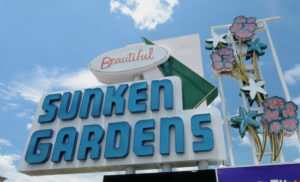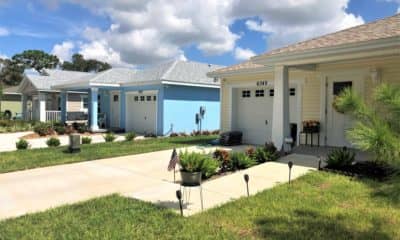Create
Vintage St. Pete: Sunken Gardens

St. Petersburg might be a very different place today if Titan Marketing Group had purchased Sunken Gardens back in 1999, as the Homosassa-based real estate company planned.
The city’s beloved 4.5-acre botanical garden, which had been designated a Historic Site just the year before, was to be transformed into a nudist resort, called Gardens of Eden.
After more than six decades of operation, attendance was at an all-time low – the Disneys and Universals had pretty well scrubbed and re-written the face of Florida tourism – and Sunken Gardens was hemorrhaging money.
“The only thing that can save Sunken Gardens at this point is a niche market,” the company’s Galen Ballard told the Orlando Sentinel. Nudism, he said, “is ideal because these are people looking for privacy and a place to go. The beauty of Sunken Gardens is those 14-foot-high walls, bougainvillea dripping over the walls. You’ve got total seclusion.”
No nudes is good nudes, however, and once the Titan deal collapsed the City of St. Petersburg – under gentle pressure from a committed group of volunteers and Old Northeast neighbors – purchased Sunken Gardens, and has been operating it for 20 years now.
 “The City is very happy that we are able to sustain ourselves,” says Jennifer Tyson, education and volunteer coordinator. “In the last several years we’ve actually increased our attendance every single year. So we’re doing very well. I think the City absolutely considers it a gem of St. Petersburg, and it’s always behind our efforts to preserve the history, and continue to bring Sunken Gardens into the modern era as well.”
“The City is very happy that we are able to sustain ourselves,” says Jennifer Tyson, education and volunteer coordinator. “In the last several years we’ve actually increased our attendance every single year. So we’re doing very well. I think the City absolutely considers it a gem of St. Petersburg, and it’s always behind our efforts to preserve the history, and continue to bring Sunken Gardens into the modern era as well.”
At this point – mid-summer – in 2018, 98,000 people visited Sunken Gardens. So far this year, the number is 123,000.
Maybe it’s locals, hungry for no-hurry nostalgia; perhaps it’s horticulture enthusiasts, eager to ogle the approximately 50,000 tropical plants on site, including more than 500 species, and marvel at the winding, below-street-level landscaping and lush rainforest canopies.
Then again, there’s likely lots of people who don’t give a flip about roller coasters, thrill rides, animatronics, 3D and long, long wait times in the blistering summer sun.
One hundred seventeen years have passed since George Turner, a Duval County farm boy, arrived in newly-incorporated St. Petersburg in search of opportunity.
For Turner, this meant a burgeoning city where land was cheap, and where his services as a plumbing contractor would be in demand.

George and Eula Turner, St. Petersburg, 1903. Family photo.
Among the properties he bought in 1911 was a scrubby five-acre lot on Northeast 4th Street. Here, he built the home where he and his new bride Eula would raise their four children. The majority of the land behind the house was consumed by a shallow lake gurgling inside an ancient sinkhole – and Turner, whose hobby was horticulture, devised a way to drain the remaining water, leaving a fertile loam as much as 15 feet deep.
Taking full advantage of St. Petersburg’s balmy tropical weather, Turner began by planting banana and papaya trees. But 20 years of winter frosts and Gulf of Mexico thunderstorms made it impractical to operate a self-sustaining, profitable fruit farm. The family produced enough to sell fruit and juice from a hand-made roadside cabin, but George continued to fit pipes and run water lines fulltime for his adopted city.
 The garden, however, remained his passion. Over the years, Turner added trees and plants from across Florida, and from around the world, developing winding tiled pathways through the exotic flora, and creating unique waterscapes to accent his dreamy landscaping.
The garden, however, remained his passion. Over the years, Turner added trees and plants from across Florida, and from around the world, developing winding tiled pathways through the exotic flora, and creating unique waterscapes to accent his dreamy landscaping.
By the 1930s, it had become a Sunday tradition for locals to wander over to the immaculately manicured Turner gardens, for peaceful afternoon strolling. Turner fenced off his property and began charging a nickel admission.
This was increased to 15 cents in 1935, which is when George Turner quit the plumbing business and devoted himself to the development, care and maintenance of what he proudly named “Turner’s Sunken Gardens.”
Winter visitors here like to carry back Turner memories of Florida’s rarer plants, traditional and lush. Towering palms and rich-foliaged banana trees, with bananas in bloom frame the less imposing plants. Roses, petunias, gladioluses, japonicas, royal poincianas, plumbago, hibiscus ramble about the gardens, appear in nooks and crannies by the rock springs and pools. Hundreds of papaya trees bear fruit and the juice is sold for the “pause that refreshes” at a little log house.
St. Petersburg Times, Dec. 19, 1937

Vintage 1960s postcard.
In a city where the main attractions were year-round warmth and sunshine, Sunken Gardens became, if not a destination, sort of a cherry on top; if you were visiting St. Petersburg, you went to the beach (were you so inclined), you visited Webb’s City (World’s Largest Drug Store!) and you strolled through Sunken Gardens. Maybe you sat on a green bench.
Turner threw open his gates at almost exactly the same time entrepreneur Dick Pope cut the ribbon on Cypress Gardens, another botanical wonderland, near Winter Haven. Whereas that location backed up to an enormous, deepwater lake and featured water-ski shows (particularly big in the 1940s and ‘50s), Sunken Gardens was merely a well-appointed garden, with caged parrots and other tropical birds squawking away between the tree stands.

Yogi Berra at the gardens, early 1960s. City of St. Petersburg.
For tourists of the time, that was enough. Florida itself was what they were coming to experience, and for more than 30 years, Sunken Gardens was one of the Top Ten highest-grossing tourist attractions in the state.
In 1959, a small botanical garden was opened on the grounds of the Anheuser-Busch brewery in Tampa. Although Busch Gardens started expanding in the mid ‘60s, in the beginning it was nothing more than the “hospitality area” for guests taking beer-making tours.
George Turner died in 1961; sons George Jr. and Ralph took over fulltime operations at Sunken Gardens.
In 1964 and ‘65, Walt Disney began buying up acres of upland and swamp in Central Florida, using an alias so sellers wouldn’t artificially jack up their prices. This would be the beginning of the end for hundreds of Florida “roadside attractions,” although nobody knew it at the time.

King of Kings. Vintage postcard.
The junior Turners plowed ahead, spending $175,000 for a vintage Mediterranean-style building adjacent to their property (built in 1926 as the Sanitary Public Market, it had later been home to the American Legion Armory; in ’66, when the family bought it, it was a Coca-Cola bottling plant). This became office space and “The World’s Largest Gift Shop.”
Adjacent to the gift shop, beginning in 1968, was an exhibit called King of Kings, a series of costumed wax figures depicting the life of Christ.
(In 2002, the vintage building was added to the National Register of Historic Places.)
Sunken Gardens survived, and even thrived, during the “golden age” of Bay Area tourist attractions (including the St. Pete Beach Aquatarium, with its popular dolphin shows, the London Wax Museum and the ascendancy of Busch Gardens once its “African Veldt” animal area was added).
The numbers, however, don’t lie. By the 1980s, attendance was falling way, way off.

Photo: City of St. Petersburg
Sunken Gardens went on the market in 1989. It remained open, doing decent if not spectacular business, maintained as always by various members of the Turner family, a dedicated staff and an army of volunteers who dearly loved the place. Residents of Old Northeast rallied around the notion of saving Sunken Gardens.
Around the time of the nudist resort fiasco, “They really sensed that Sunken Gardens could be lost,” Tyson relates. “It had been 10 years, there were many different failed contracts on it, and so eventually the public, along with some long-term Sunken Gardens employees, really tried to get the community involved. Thinking that with community involvement the City might be more likely to purchase the gardens.”
Enough signatures were gathered to convince the City to propose a one-time property tax, to purchase the six historic acres. It went through, and St. Petersburg bought Sunken Gardens from three Turner grandsons, for $3.8 million, in 1999. “It was really a community grassroots effort to save the gardens,” Tyson says with pride.
The King of Kings waxworks were sold to an Iowa church; the lobby/gift shop is currently undergoing a six-week renovation, to be paid for through the “Penny For Pinellas” tax. (The Great Explorations Children’s Museum, housed in the facility, is not affected by the construction).
Today, Sunken Gardens is maintained by a small City staff, the grounds rigorously maintained and manicured by a full-time foreman and assistants, plus a veritable army of volunteers.
Likewise, there’s a full-time animal husbandry specialist, and accompanying staffers and volunteers, to look after the small flock of Chilean flamingos (purchased for the gardens in 2017 by the “Sunken Gardens Forever Foundation”), and the other exotic birds housed on the property.
Approximately 250 weddings took place on the gardens’ manicured North Lawn, and at other leafy spots, in 2018.
In the works: New, more natural enclosures for the birds, a cactus garden and a children’s garden.
Although she’s only been on the staff for three years, Tyson is as dedicated to the care and feeding of Sunken Gardens as if she were an old-timer. It has that effect on people.
“We all wear a lot of different hats,” she says. “and do our best to care for the gardens, and preserve it for the future.”
Sunken Gardens’ website is here.
This story appears in the book Vintage St. Pete: The Golden Age of Tourism and More.








